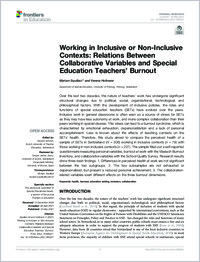Working in Inclusive or Non-Inclusive Contexts: Relations Between Collaborative Variables and Special Education Teachers’ Burnout
IPC
- Squillaci, Myriam ORCID University of Fribourg
- Hofmann, Verena University of Fribourg
- 18.05.2021
Published in:
- Frontiers in Education. - Frontiers Media SA. - 2021, vol. 6, p. 640227
English
Over the last two decades, the nature of teachers’ work has undergone significant structural changes due to political, social, organizational, technological, and philosophical factors. With the development of inclusive policies, the roles and functions of special education teachers (SETs) have evolved over the years. Inclusive work in general classrooms is often seen as a source of stress for SETs as they may have less autonomy at work, and more complex collaboration than their peers working in special classes. This stress can lead to a burnout syndrome, which is characterized by emotional exhaustion, depersonalization and a lack of personal accomplishment. Less is known about the effects of teaching contexts on the SETs’ health. Therefore, this study aimed to compare the perceived health of a sample of SETs in Switzerland (N = 306) working in inclusive contexts (n = 79) with those working in non-inclusive contexts (n = 227). The sample filled out a self-reported questionnaire measuring personal variables, burnout at work with the Maslach Burnout Inventory, and collaborative variables with the School Quality Survey. Research results
show three main findings. 1. Differences in perceived health at work are not significant between the two subgroups. 2. The two subsamples are not exhausted or depersonalized, but present a reduced personal achievement. 3. The collaboration related variables exert different effects on the three burnout dimensions.
show three main findings. 1. Differences in perceived health at work are not significant between the two subgroups. 2. The two subsamples are not exhausted or depersonalized, but present a reduced personal achievement. 3. The collaboration related variables exert different effects on the three burnout dimensions.
- Faculty
- Faculté des lettres et des sciences humaines
- Department
- Département de Pédagogie spécialisée
- Language
-
- English
- Classification
- Psychology
- License
- Open access status
- gold
- Identifiers
-
- DOI 10.3389/feduc.2021.640227
- ISSN 2504-284X
- Persistent URL
- https://folia.unifr.ch/unifr/documents/319867
Statistics
Document views: 110
File downloads:
- frontiersms_vh: 176
